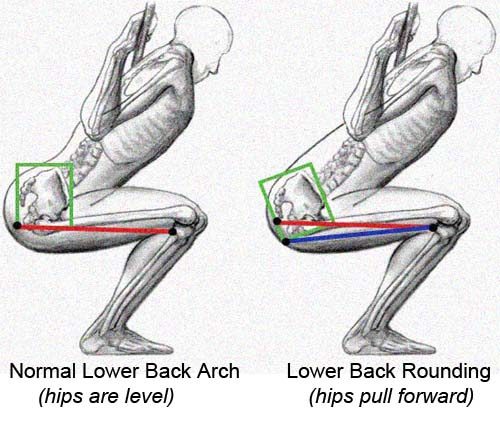
Avoiding the Butt Wink
It sounds cute and fun, but after it happens, you may not think so! The butt wink is probably one of the more common topics among the fitness industry. What causes it and how to stop it can be different for everyone. Like most things – there is not a one size fits all. I do think; however, that we can all agree we want to be avoiding the butt wink.
What exactly is this butt wink?
Squats are my favorite exercise. They build big, strong, balanced legs and there are so many variations. They are one of the most functional movements and can make everyday activities safer if they’re done properly. However, performing a squat with incorrect form can cause injuries and have the opposite effect.

During a squat, the butt wink is essentially a posterior pelvic tilt that can occur at the bottom of the movement, or more simply put, it’s when the pelvis tucks underneath the body. When this occurs, it puts the lumbar spine in flexion at the bottom of the squat. This is almost always followed by spinal extension on the way up. Once the spine goes into flexion, it’s very difficult to maintain a neutral spine on the way back up. People often start a squat in spinal extension, then lower and perform the butt wink. This whole process puts the spine in extension, flexion, and back to extension. Now this wouldn’t be TOO terrible if these were body weight squats, but once a load is added onto the axial skeleton, it’s a whole different story.
Adding load to the spine and then moving it through flexion and extension rather than a neutral position adds wear and tear to the spinal discs and can risk a bulge or herniation. In addition to damage to the lumbar vertebrae, poor squatting form can lead to pelvic and spinal ligaments to try to stabilize the body. If ligaments are put under too much stress, they can tighten up and cause pain by pulling on the joints.
Obviously squatting with proper form is extremely important, especially if a load is added onto the body.
So what causes it?
The most common reason for the butt wink is tight hamstrings; however, other muscles of the pelvis can contribute to the dysfunction as well if they are imbalanced. Tight hamstrings will pull the pelvis into a posterior tip at the bottom of the squat due to the lack of flexibility or range of motion. The pelvis cannot lower naturally because of the pull, so the spine has to compensate. However, during the eccentric, or lowering, phase of the squat, the hamstrings are also shortening due to the knees bending. So the muscle group is lengthening at the hip joint but shortening at the knee joint. This would ultimately mean there is not too much change in the muscle length.
If hamstrings are not the main culprit, what is? It is different for everyone, but what is not common knowledge is the ligaments of the pelvis and the restriction they can cause. The sacrotuberous ligament has direct fascial connections to the hamstrings and can get locked up due to chronically tight hamstrings. If the sacrotuberous ligament becomes locked, range of motion in the hip is limited. Thus, the bottom of the squat will be restricted unless the spine takes over to get lower. Thus, enter the butt wink.
Fixing the butt wink!!
Increase hip mobility! Reciprocal inhibition can cause tight hip flexors to make it difficult for the glutes to fire. This leads to pelvic ligaments trying to perform hip extension because the glutes are asleep. Then the pelvic ligaments end up getting tight due to the pull from the hamstrings, and the butt wink occurs.
The King Aurthur stretch is excellent at lengthening the hip flexors and standing or seated hamstring stretches are both good options to lengthen the hamstrings as well. As for pelvic ligaments, sit on a lacrosse ball and try to take your mind off that literal pain in the…!
Something I haven’t mentioned yet is that some people are just built with sockets that are deeper and have a limited range of motion. When there is a structural component to it, the solution would really be to squat as low as possible without breaking a neutral spine or alter the squat stance.
Another option for those of you who have limited mobility would be an exercise called Sumo squats. There is less hip and ankle flexion needed and the torso stays more upright which can allow for a neutral spine to be maintained easier. To perform a sumo squat, take a wide stance, outside shoulder width, and externally point out the feet at roughly 45 degrees.
photo by https://www.theptdc.com/how-to-fix-butt-wink
Written by Danielle Barker
